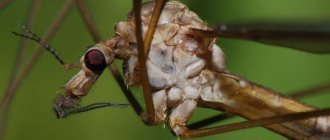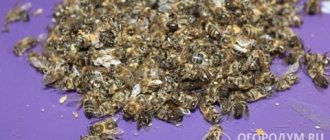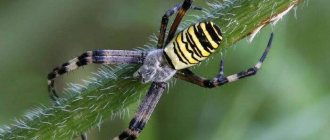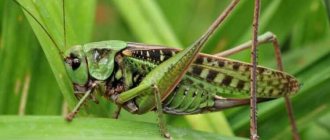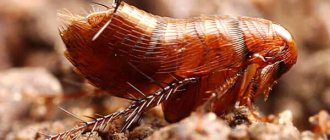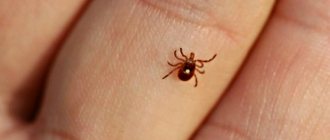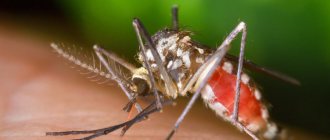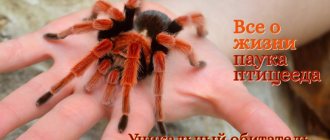Mosquitoes are two-winged insects that cause discomfort to humans in spring and summer. After their bite, local itching, redness, and swelling appear. But these are harmless symptoms compared to the harm mosquitoes that carry diseases such as encephalitis, malaria, and fever can cause to health. To defeat these insects, you need to know the duration and characteristics of their life.
Why do mosquitoes drink blood?
Although male and female mosquitoes have the same nature, they feed differently. Males drink nectar, eat pollen, and even provide benefits by pollinating flowers. Females also feed on plant sugars, but after mating they begin to hunt for blood. Fertilized insects attack people and animals. They need blood to breed full-fledged offspring.
There is an opinion that a mosquito dies after drinking human blood. This statement is overly optimistic: the female will die only if she is swatted during an attack. If she avoids death at the hands of her victim, then the blood she drinks will benefit her and prolong her life.
A well-fed mosquito hides for several days, digesting food, and then goes in search of a reservoir with warm stagnant water. This could be a nearby pond, rain barrel, swamp or puddle. She lays eggs in water rich in organic matter. Drinking blood, containing protein and useful substances, allows it to breed healthy offspring and not die after laying.
At one time, the female of an ordinary mosquito lays from 50 to 200 tiny white eggs, while a female mosquito lays up to 280 eggs. After laying, the insect quickly comes to its senses and goes for a new portion of blood. It is capable of laying eggs once every two to three days until death.
If the female mosquito fails to suck blood, she will still lay eggs. She will take the necessary nutrients from her own body and die after laying. The offspring produced will be weakened and inferior.
How long can a mosquito live in an apartment without blood after being bitten?
Although dipterous insects have the ability to adapt to climatic conditions, temperature plays a big role for them, affecting their lifespan.
Speaking about the life of a female, she can live for up to:
- 43 days at a temperature of 23 degrees or more,
- 58 days at a temperature within 2023 degrees,
- 114 days, if the temperature is 1520 degrees,
- 120 days at 1015 degrees.
If we talk about the life of a male, then under the same conditions, they will live half as long, and in the case of mating, their life will last no more than 5 days; females are not limited at this point.
So, since the temperature in the apartment is usually 2025 degrees, females can live approximately 4560 days, and males no more than a month. If the female has the opportunity to feed on blood, then she will be able to regularly lay larvae in a damp place in the apartment, thereby populating the room with new generations of mosquitoes.
In order to exclude the possibility of mosquitoes entering the living space, mosquito nets can be placed on the windows, but this, of course, is not 100% protection against insects, since they can enter the house through the entrance doors.
Now a huge variety of special protective equipment is sold on the market, but not all of them are suitable due to the chemical composition, especially if an allergy sufferer or small child lives in the apartment. The safest option is to keep indoor plants such as geranium, elderberry, marigold, basil, lemongrass, lilac, and bird cherry. In addition, effective methods are the use of aromatic oil (geranium, eucalyptus, cedar, anise, tea tree, basil are suitable),
Life cycle of an insect
Like most insects, a mosquito goes through 4 stages during its life: egg, larva, pupa, imago (as scientists call a mature individual). The insect develops in water, and only comes to land when it becomes an adult.
The eggs laid by the female float on the water in the form of small rafts consisting of 20-30 eggs. The time for the larvae to emerge from them depends on the water temperature and ranges from 40 hours to 8 days. Mosquito larvae are easy to spot in water: they are constantly in an upright position. Their food consists of microorganisms. They grow quickly, molt three times and pupate after 4-5 days.
The pupa remains motionless at the surface of the water, with its spiracle tubes exposed. After 5 days, an adult mosquito flies out, ready to reproduce. Males hatch first, followed by females.
Panic in southern Russia
The Rostov region is the “homeland” of Russian West Nile fever.
Doctor of Sciences, Head of the Department of Infectious Diseases of the Rostov State Medical University (Rostov State Medical University) Yuri Ambalov was the first domestic virologist to encounter an invisible disease in 1999. Then he and a group of scientists went to the village of Oblivskaya, where a mysterious epidemic was announced.
Scientist Yuri Ambalov has been studying fever for 20 years. Photo: Rostov State Medical University
Patients with high fever and chills were admitted to the hospital. Five people died, three of them were children. Panic arose in the village. “Cholera” posters were hung along the coastline; all vacationers were sent home by police in cotton and gauze bandages.
Article on the topic
Microbes of the future. What new epidemics threaten humanity?
Residents recall that dead silence reigned in the village. Those who could went to their relatives, others did not leave the yard. Neither local nor regional doctors could qualify the disease, so epidemiologists from Moscow came here.
“I remember well what trouble happened in Oblivskaya. We didn't know then that it was West Nile fever. At least 100 people fell ill. I got out of the car, and mosquitoes immediately swarmed me,” recalls Yuri Ambalov. – A few weeks later, a similar thing happened in the neighboring Volgograd region - mosquitoes flew there with the wind. Then this disease was called Crimean-Congo hemorrhagic fever, which is transmitted from a tick bite. But now we understand that it was West Nile fever.”
What does life expectancy depend on?
In laboratory conditions, female mosquitoes live up to 120 days, males - 2 times less. Such a difference in life expectancy between insects of the same species has no explanation.
In laboratories, mosquitoes live longer than in the wild, since they have adequate nutrition and optimal temperature conditions. There is no exact data on how long they live in natural conditions.
Scientists have found that the life of a mosquito is influenced by the following factors:
- Air temperature. Insects do not tolerate hot weather well. The cooler it is in the house or outside, the longer their life. At air temperatures above +25 ºC, mosquitoes live up to 42 days, at +10 ºC up to 120.
- Frequent meals. To live long, male mosquitoes must regularly receive food in the form of nectar, and females must obtain blood. In forests and other uninhabited areas, mosquitoes live less because they do not find suitable food for themselves.
- Weather. Mosquitoes live longer and reproduce better in calm, windless weather. Frequent downpours, strong winds, heat, and sudden temperature changes shorten the life of insects and destroy their offspring.
If mosquitoes appear in late summer or early autumn, they hibernate before the onset of winter. In the spring they wake up, live and reproduce for another 1-2 months.
Lifespan of mosquitoes
The lifespan of mosquitoes is influenced by factors:
- sex of the individual;
- air temperature;
- humidity level;
- availability of food.
The average lifespan of males is 3 weeks, females - 2 months. At an optimal temperature of +10...+15 oC, females can live up to 119 days. At +20 °C their lifespan is reduced to 57 days, at +25 °C - to 43 days. These figures are valid if mosquitoes have access to carbohydrate food and the air humidity in their habitat is high.
Attention! At temperatures below +10 ° C, mosquitoes fall into torpor. They can remain in this state until spring. Then the time during which the insect “slept” is added to the lifespan.
How long do different species live?
The lifespan of all types of mosquitoes is approximately the same. Insects living in the Arctic live the shortest. There they appear for several weeks, when water bodies form in the permafrost under the influence of heat. In a short time, the parasites manage to pay in huge quantities.
As part of the midges, mosquitoes attack animals and people. Their main victims are herds of caribou. On a day, bloodsuckers manage to drink up to 300 ml of blood from each animal.
A new species of mosquito has appeared in megacities – the urban one. It lays eggs in the basements of houses. The larvae develop in a humid environment and from there fly into apartments. These mosquitoes remain active all year round. It is not uncommon for them to lay eggs in bathrooms, toilets and closets, and then flocks of hungry bloodsuckers emerge from there.
Mosquitoes do not live long, but during their short life they manage to cause a lot of trouble to people and animals. But the complete destruction of bloodsuckers cannot be allowed, as this will disrupt the ecological chain: fish and birds feed on mosquitoes and their larvae.
How to recognize a fever
West Nile fever is an acute infectious viral disease. Out of 100 people who get sick, four to five people die.
Symptoms of the disease are a sharp deterioration in health, increasing headache, high temperature, tremors in the body, nausea, and vomiting may be observed. Fever is often confused with ARVI, so the diagnosis is determined only in the hospital. The most terrible complication is meningitis, that is, inflammation of the membranes of the brain.
Today, only personal protective equipment - sprays, ointments, plates that repel mosquitoes - will help you protect yourself from mosquitoes. Fever vaccines are in the testing phase.
How many times can a mosquito bite?
Theoretically, the possibilities are unlimited. The female pierces the human skin, inserts her proboscis into the wound, and begins to suck blood. To facilitate feeding, it injects saliva. One mosquito can bite once, if it is not prevented, a “successful” place on the body will be chosen, or several times.
On a note!
For complete saturation, the female requires 5 ml of blood. She sits calmly, sucks, increases in size, and her abdomen becomes red. However, if blood stops actively flowing into the proboscis, the insect moves to another place. A mosquito can bite up to 5 times during the night. And also risks dying as soon as it bites through the skin.
Food preferences
Many people notice that mosquitoes can bite one person twice, bite another completely, and not touch a third at all.
- Insect bites are usually located in areas not covered by clothing, a blanket, or thin fabric.
- Mosquitoes are attracted by the smell of lactic acid, carbon dioxide, and heat. Children are much more likely to suffer from mosquito attacks. This is explained by thin skin, rapid metabolism with intense release of lactic acid and heat.
- The smells of females attract and repel. Men's cologne acts as an effective repellent, while sweet women's perfume attracts the attention of pests.
- More often, people who sweat a lot, suffer from hormonal disorders, and heart disease complain of mosquito bites. Females are attracted to increased levels of estrogen, testosterone, cholesterol, nonanal, and steroids. At risk are pregnant women, people with diabetes, and men who play sports.
Short description
The mosquito belongs to the class of insects, order Diptera, family of blood-sucking mosquitoes.
This creature has lived on the planet for more than 145 million years. It is active in the warm season - at the end of spring, in summer. They are distinguished by a characteristic squeak, an unpleasant bite, which is accompanied by severe pain. In nature, there is a huge variety of mosquito species, which differ in body structure, size, lifestyle, bite pattern and other factors. But many of them prefer to feed on the blood of humans and animals.
To understand what a mosquito looks like, it is worth considering its main appearance features:
- the insect has functioning wings, with the help of which it is able to fly over long distances. The span reaches 3 cm. The top is covered with scales;
- three pairs of thin long legs, at the end there are claws with which they cling to the surface;
- his body is oblong;
- the parasite has a wide chest, an abdomen consisting of 10 segments, which is supported by long legs;
- on the surface of the head there are invisible antennae and a proboscis, with which it pierces the skin and then the wall of a blood vessel, biting and sucking blood.
The squeak mosquito has a gray or brown body color. But there are species of insects that have orange, yellow, green, and red colors. Some members of the family have lush brushes on their wings and legs.
Insects don't fly that fast. The flight speed of a mosquito is 3.2 km/hour. Sometimes wingless varieties are found.
Can mosquitoes kill a person?
Given the lack of a sense of proportion in relation to blood in mosquitoes and the size of their population, a logical question arises whether mosquitoes will be able to suck out all the blood.
Scientists seriously asked this question and compared some numbers. There is no clearly defined blood volume in the human body. This value can change either up or down. It was generally accepted that an adult of average build has about 5 liters of biological fluid. Calculations were made based on the fact that per 1 kg of human body weight there is about 75 ml of blood.
Mosquito bite
It is not possible to accurately calculate how many mosquitoes are needed to drink all the blood from a person, so theoretical data is taken as a basis. If the average bloodsucker drinks only 5 mg of blood at a time, then it would take at least 1000 individuals to kill a person, provided that each one fills its belly completely. It is difficult to encounter such a situation in real life.
A weak human immune system can also bring death closer. It will give a strong allergic reaction to anticoagulants administered by bloodsuckers, and will provoke swelling and suffocation.
Also, in order to bring the human body to complete bleeding, it is necessary to exclude any drink and food. In ordinary life this is not possible.
Thus, the answer to the question of whether mosquitoes can bite to death has only a speculative answer based on generally accepted facts. But even one mosquito bite will be enough to introduce a dangerous disease into the body. And it can already cause death.
How to get rid of mosquitoes?
Mosquitoes can sometimes seem elusive, but people are not powerless against these little vampires. There are several ways to evict mosquitoes from your home and prevent them from coming back:
- Keep your front doors closed as much as possible.
- Use mosquito nets on windows that are properly installed and have no tears or holes.
- If you leave entry doors open to ventilate the area, install a well-fitting door mosquito screen that will keep insects out.
- Since mosquitoes love warm, humid climates, use air conditioning regularly to reduce indoor humidity as much as possible.
- Drain (and renew if necessary) any standing water in vases, flowerpot saucers, etc. inside your home.
- Consider using mosquito repellent in warm, damp areas of your home, such as the laundry room or bathroom.
- Refresh pets' water bowls regularly, wiping them down to eliminate mosquito eggs or larvae before adding fresh water.
Any source of dampness in your home can provide ideal living conditions for mosquitoes. This may apply to the sink drain pipe, especially if the sink is not used very often (as the water stagnates and is not flushed regularly). Indoor plants can also become home to mosquitoes, especially moisture-loving species. Make sure you don't water your houseplants too often; This is not only harmful to plants, but also provides an ideal moist habitat for egg laying and mosquito life.
Mosquitoes in drainpipes
If you suspect mosquitoes are living or laying eggs in your home's drainage system, there are several ways to get rid of these blood-sucking insects. First, try pouring a cup of vinegar down the drain and then cover the drain with a rag soaked in vinegar. This needs to be done for at least a few hours, but better all day if you can stand the strong smell of vinegar. Then rinse the drain thoroughly with hot water.
Another method is to pour a cup of bleach down the drain and flush again with hot water. This method will take less time than with vinegar
However, it must be taken into account that the fumes from bleach can damage plastic pipes, as well as a person's lungs and nasal passages, so this method should be used with caution
